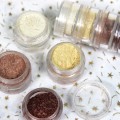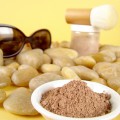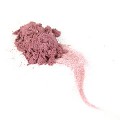Making lipsticks is just like making lip balms – except with about ten times the color. Since Bramble Berry’s Lipstick Kit*was included in the holiday gift roundup for the Boston Herald newspaper, we’ve been getting some questions about making lipstick. This week’s blog posts will focus on making lipsticks from scratch (along with the usual random musings, cupcake cravings and business round-ups). Before we get started on our product, let’s discuss ingredients for lipstick. The most important consideration when making lipstick is the colorant – the types you can use, what they are and safety considerations.
*UPDATE: This kit has been discontinued. Click here for more kits.
Titanium Dioxide—Titanium dioxide is a mined mineral, famous for its natural SPF factor. It is an inert, flat oxide that provides for opacity in lipsticks and foundations. If used too heavily, it will leave your skin pale and chalky. It has natural UVA and UVB protection. Because of its fine grind, it allows the skin to breathe and have a healthy exchange with the environment. In lipstick, it helps to add color to the lips because it provide opacity. Sheer glosses will have little to no titanium dioxide in them.
 Mica (also called Sericite) – Mica is a naturally colorless mineral that is mined from the earth in large, flat sheets. This product can also be manufactured in a lab and much of what is used in our makeup today is the manufactured product. Mica reflects and refracts light, adding shimmer and sheen to your foundation, your eye makeup and lipstick. When the flat mica platelet is coated with color, it becomes the perfect base for eye shadow. Mica can be coated with a variety of things, from FD & Cs and oxides to dyes and carmine. Even though it is naturally occurring and sometimes mined, when individual mica platelets are covered in FD&C colorant, it is categorized as an FD&C colorant. If you are classifying your product as “all natural,” be sure that the mica you are using is not coated in FD&C based colors. The dual sided nature of the mica color platelets is what causes the shimmer and sheen of micas. Mica is the same stuff you see in your lipstick, eye shadow and blush. Micas work best in clear products, like clear melt and pour, because the shimmer needs light in order to reflect and refract nicely. On the lips, with the thin layer put down, the mica shimmer will come through well. The more titanium dioxide that is used, the less shimmer and shine will show up in the final product. Not all micas are approved for use on lips. You’ll need to research with your vendor if the micas you have are lip safe. Click here to see the list of lip and eye shadow safe Bramble Berry colors.
Mica (also called Sericite) – Mica is a naturally colorless mineral that is mined from the earth in large, flat sheets. This product can also be manufactured in a lab and much of what is used in our makeup today is the manufactured product. Mica reflects and refracts light, adding shimmer and sheen to your foundation, your eye makeup and lipstick. When the flat mica platelet is coated with color, it becomes the perfect base for eye shadow. Mica can be coated with a variety of things, from FD & Cs and oxides to dyes and carmine. Even though it is naturally occurring and sometimes mined, when individual mica platelets are covered in FD&C colorant, it is categorized as an FD&C colorant. If you are classifying your product as “all natural,” be sure that the mica you are using is not coated in FD&C based colors. The dual sided nature of the mica color platelets is what causes the shimmer and sheen of micas. Mica is the same stuff you see in your lipstick, eye shadow and blush. Micas work best in clear products, like clear melt and pour, because the shimmer needs light in order to reflect and refract nicely. On the lips, with the thin layer put down, the mica shimmer will come through well. The more titanium dioxide that is used, the less shimmer and shine will show up in the final product. Not all micas are approved for use on lips. You’ll need to research with your vendor if the micas you have are lip safe. Click here to see the list of lip and eye shadow safe Bramble Berry colors.
 Iron Oxides—Iron oxides, commonly called pigments, were once mined. Since the 1970s, the FDA has demanded they be lab-created for cosmetic use because iron oxides in nature are often attached to toxic metals like lead, arsenic, mercury, antimony, and selenium. Their purity and safety from naturally occurring sources can’t be guaranteed. The lab-created pigments have the same molecular structure and same quality of color, just a different creation process and a purer, safer end product. Only synthetically prepared iron oxides are approved for use in cosmetics in this country. (Johnson, S.T. & Wordell, C.J. “Homeopathic and herbal medicine: Considerations for formulary evaluation,” Formulary, 32, 1167, Nov. 1997.) To achieve vibrant and beautiful colors, iron oxides are prepared in the lab using iron salts, which are then oxidized using a controlled water process. Iron oxides are safe, pure, and vibrant. Not all oxides and pigments are approved for use on lips. You’ll need to research with your vendor if the micas you have are lip safe. Click here to see the list of lip and eye shadow safe Bramble Berry colors.
Iron Oxides—Iron oxides, commonly called pigments, were once mined. Since the 1970s, the FDA has demanded they be lab-created for cosmetic use because iron oxides in nature are often attached to toxic metals like lead, arsenic, mercury, antimony, and selenium. Their purity and safety from naturally occurring sources can’t be guaranteed. The lab-created pigments have the same molecular structure and same quality of color, just a different creation process and a purer, safer end product. Only synthetically prepared iron oxides are approved for use in cosmetics in this country. (Johnson, S.T. & Wordell, C.J. “Homeopathic and herbal medicine: Considerations for formulary evaluation,” Formulary, 32, 1167, Nov. 1997.) To achieve vibrant and beautiful colors, iron oxides are prepared in the lab using iron salts, which are then oxidized using a controlled water process. Iron oxides are safe, pure, and vibrant. Not all oxides and pigments are approved for use on lips. You’ll need to research with your vendor if the micas you have are lip safe. Click here to see the list of lip and eye shadow safe Bramble Berry colors.
The good thing about using pigments in makeup is that they are stable. They are also cost effective; at $3-$6 per ounce, you’re looking at a very cheap, per pound price, for color.
Natural Colorants—There is no legal definition for a natural colorant. FDA classifies colorants as either those requiring certification and those not requiring certification. “Exempt colorants are inherently neither more nor less safe than certified colorants,” concludes an article in the Encyclopedia of Chemical Technology. We may consider them as less hazardous because we perceive them as “natural.” But “like all color additives, they are fabricated products.” Historically, bugs were ground up for colorant. Cochineal (the boiled and ground nymphs of the Coccidae, or scale insects) were crushed by the Aztecs and Mayans for a nice red color. Today, potential customers get squeamish about that so we skip the bugs.
Some popular natural colorants to use are:
Yellow – Annatto, Saffron, Turmeric, Carthamin
Green – Chlorophyll
Brown – Cocoa beans (pods, shells, stems), cocoa powder, fermented tea
Red – Paprika (may be irritating)
Purple – Alkanet Root
The list goes on of course.
The nice part about using these colorants is their marketability as natural products. However, it is difficult to achieve the color you want using natural colorants. Natural colors also lack consistency, so you can’t always get a smooth color (depending on the herb or spice used), and they are expensive to use. Additionally, many of them are not oil soluble so will not blend into the lipstick base smoothly.
Tomorrow’s blog post will discuss equipment needed and specific base ingredients.






Can I just use the lip bomb base that you have on Bramble Berry? how do I make the color come on to your lips and not just change the color of the product?
You can absolutely use the lip balm base we have on Bramble Berry. My favorite base is our Vegan Lip Balm which is so soft and good for your lips.
https://www.brambleberry.com/Vegan-Lip-Balm-Base-P5231.aspx
All you need to do to get the color to ‘stain’ to your lips is add more pigment or colorant!
-Becky with Bramble Berry
Quick question… I dont have a mircowave and was wondering if you could use a double boiler to make lip balm. I do it for soap and it works. and any tips would be helpful. I have brought my frist lip balm making kit. and want to try it. sorry I didnt buy it from BB becuase the one was too much and such. any help or information would be helpful. thanks
Definitely – just don’t walk away too far because hot wax/oil on a burner can catch flame so watch it when you’re doing it.
=) Good luck – and enjoy the project! It is fast, fun and easy.
thank you and will watch closely for sure.
Hi Tabitha,
Generally, carmine is only found in reds and pinks so those are the colorants you would want to check the ingredient lists for. The INCI (ingredient list) will list Carmine as a component of the color if it is in the product so if your vendor lists all the INCIs for all their colorants online, a quick glance will help you out. =) http://www.BrambleBerry.com typically has the INCI's listed on the product description so you can see at a glance what the ingredients are.
Have fun making lipsticks!
I will be making all natural vegan lipstick, what do I need to look for in micas to make sure they aren't FD&C based and don't have carmine in them? Will I have to email the company to ask about every color I want? Thank you!!!
Heidi, that’s the beauty of making your own – YOU decide what you want in the product and are comfortable with. I really hope you’ll give it a try when the tutorial is done. =)
great topic and I am looking forward to the rest of the story.
Michelle in NV
I’m with Joanna on this one, however, this is very interesting information. I stopped using regular lipsticks because you just end up eating them and I can’t pronounce 99% of the ingredients…
I’m more of a tinted lip-balm fan myself and my mind keeps drifting back to those to-die-for little lipbalm tins — 😉
SingingWolf, good question! Not all micas and oxides are approved for use on lips. You’ll need to research with your vendor if the colors you have are lip safe. The general rule of thumb is that blues and greens are not safe in the oxides but most of the reds in the oxides are safe. Anything “ultramarine” is not usually safe. But definitely double check with the vendor you got the oxides and pigments from to be on the safe side.
Funny, the site wouldn’t let me comment last night. 🙁
You’ve got a non-cosmetic wearer interested in making lipstick.
Are all soap safe ultramarines and oxides also lip safe?
I like the idea of making my own, but honestly, I’ll leave it to the pros.
Nice descriptions and useful information on the colorants, thank you!
-Joanna